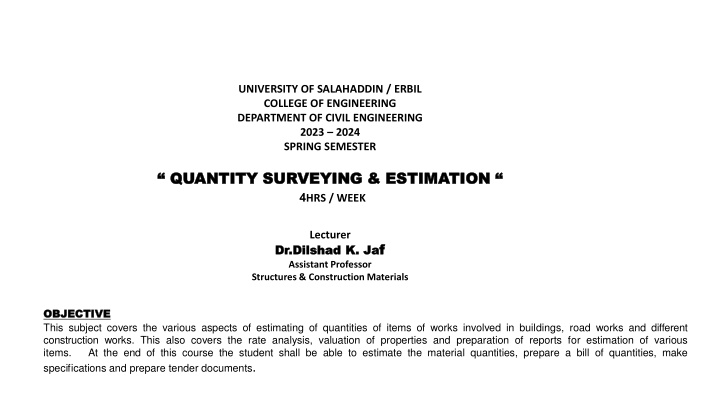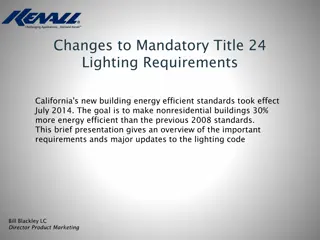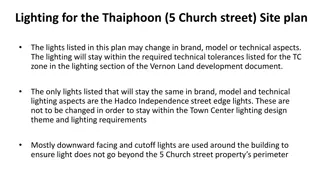Lighting Design for a Villa Building
This assignment focuses on illuminating the exterior of a villa building placed in a garden using techniques like fa ade lighting, accent lighting, uplighting, wall grazing, and landscape lighting. The design aims to enhance the architectural features and create a visually appealing environment during night time.
Download Presentation

Please find below an Image/Link to download the presentation.
The content on the website is provided AS IS for your information and personal use only. It may not be sold, licensed, or shared on other websites without obtaining consent from the author.If you encounter any issues during the download, it is possible that the publisher has removed the file from their server.
You are allowed to download the files provided on this website for personal or commercial use, subject to the condition that they are used lawfully. All files are the property of their respective owners.
The content on the website is provided AS IS for your information and personal use only. It may not be sold, licensed, or shared on other websites without obtaining consent from the author.
E N D
Presentation Transcript
UNIVERSITY OF SALAHADDIN / ERBIL COLLEGE OF ENGINEERING DEPARTMENT OF CIVIL ENGINEERING 2023 2024 SPRING SEMESTER QUANTITY SURVEYING & ESTIMATION QUANTITY SURVEYING & ESTIMATION 4HRS / WEEK Lecturer Jaf f Dr.Dilshad Dr.Dilshad K. Assistant Professor Structures & Construction Materials K. Ja OBJECTIVE OBJECTIVE This subject covers the various aspects of estimating of quantities of items of works involved in buildings, road works and different construction works. This also covers the rate analysis, valuation of properties and preparation of reports for estimation of various items. At the end of this course the student shall be able to estimate the material quantities, prepare a bill of quantities, make specifications and prepare tender documents.
INTRODUCTION Definition of Quantity Survey Quantity survey is a schedule of quantities of all the items of work in a building.Quantity surveying and the estimated quantities of materials required on a project are normally determined by professional surveyor or engineer. Quantity surveying is an assessment of the cost based on certain rates of materials and labor. An estimate should be realistic assessment should be made on actual conditions of market. Estimation is undoubtedly one or the most important aspects of a construction project. A good estimation saves the expenditure to a great extent and ensures optimum use of materials. Estimation is very much technical. It requires good knowledge on structural design, properly or engineering materials and essentially practical experience. Essentials in a good Quantity Surveyor What are the essentials in a good Quantity Surveyor? He must be able to describe clearly in proper unambiguous language the requirement of the Architect and so arrange his bill of quantities (BoQ) that the Builder can quickly, easily and accurately arrive at the estimated cost or the work. The Quantity Surveyor must have a sound knowledge or building materials and construction and or customs prevailing in the trade. He must be accurate in his work and calculations.
Importance of Quantity Survey 1. Quantity survey is essential to estimate before the construction starts the probable cost of construction for the complete work. The construction cost includes cost of materials, cost of transportation, cost of labor, cost of scaffolding, cost of tools and plants, establishment and supervision charges, cost of water, taxes and reasonable profit of the contractor, etc. The estimate is required in inviting tenders for the works and to arrange contract for a complete project. 2. Quantity survey is required to estimate the quantities of the various materials required and the labor involved for satisfactory completion of a construction project. 3. It is also useful to check the works done by contractors during and after the execution. Also the payment to the contractor is done according to the actual measurements of the completed part of each item of work. 4. A complete quantity survey or estimate is useful to provide useful advice to clients on: (i) Valuation of properties (land and building) for sale, purchase and mortgage etc. (ii) Fixation of standard rent. (iii) For insurance and claim for damages in a building. (iv) For the process of resolving disputes by referring to a third party.
Data Required for the Preparation of an Estimate or Quantity Survey 1. Drawings Complete and fully dimensioned drawings (i.e. plans, elevations, sections and other details) of the building or work in question are required. 2. Specifications Detailed specifications, giving the nature, quality and class of work, materials to be used, quality of the material, their proportions, and method of preparation are required. 3. Rates The rates of various of work, materials to be used in the construction, wages of different categories of labor (skilled or unskilled) and cost of transportation charges should be available for preparing an estimate of work cost. 4. Actual Finished Work Quantities can be calculated from the actual work done in the project site.
The quantities mainly can be calculated as: Quantity = Volume = Length Width (Height or Thickness) ( m3 ) Quantity = Volume = Area of cross-section Length ( m3 ) Quantity = Area = Length Width ( m2 ) Quantity = Length ( m. l) Quantity = Number of Units or Sets ( No., Set) Quantity = Weight ( kg ,ton) Quantity = Lump sum ( L.S.)
Units of Measurements The units of measurements are mainly categorized for their nature, shape and size and for making payments to the contractor and also. The principle of units of measurements normally consists the following: 1. Single units work like doors, windows, trusses etc., is expressed in numbers.( No. ) 2. Works consists linear measurements involve length like fencing, hand rail, bands of specified width etc., are expressed in running meters (m.l). 3. Works consists areal surface measurements involve area like plastering, color painting, partitions of specified thickness etc.,are expressed in square meters ( m2 ). 4. Works consists cubical contents which involve volume like earth work, cement concrete, Masonry etc., are expressed in Cubic meters ( m3 ).
Rules for Measurements The rules for measurement of each item are listed below : 1. Measurement shall be made for finished item of work and description of each item shall include materials, transport, labor, fabrication tools and plant and all types of overheads for finishing the work in required shape, size and specification. 2. In booking, the order shall be in sequence of length, breadth and height or thickness. 3. All works shall be measured subject to the following tolerances. I. linear measurement shall be measured to the nearest 0.01m. II. Areas shall be measured to the nearest 0.01 square meter III. Cubic contents shall be worked-out to the nearest 0.01 cubic meter 4. Same type of work under different conditionsand nature shall be measured separately under separate items. 5. The bill of quantities shall fully describe the materials, proportions, workmanships and accurately represent the work to be executed. 6. In case of masonry (stone or brick) or structural concrete, the categories shall be measured separately and the heights shall be described: i. From foundation to plinth level. ii. From plinth level to first floor level. iii. From Fist floor to second floor level and so on.
Requirements of Estimation and Costing 1. Estimate gives an idea of the cost of the work and hence its feasibility can be determined i.e. whether the project could be taken up with in the funds available or not. 2. Estimate gives an idea of time required for the completion of the work. 3. Estimate is required to invite the tenders and Quotations and to arrange contract. 4. Estimate is also required to control the expenditure during the execution of work. 5. Estimate decides whether the proposed plan matches the funds available or not Procedure of Estimating or Method of Estimating. Estimating involves the following operations 1. Preparing detailed Estimate. 2. Calculating the rate of each unit of work 3. Preparing abstract of estimate






















